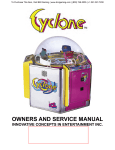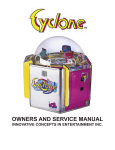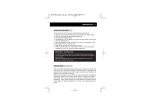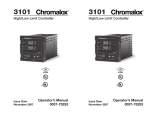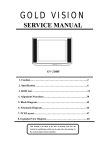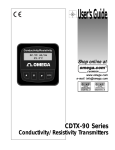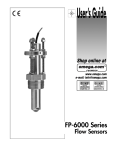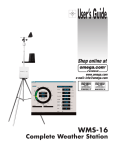Download Chromalox Omega CN2110 User's Manual
Transcript
User’s Guide 10 21 °F lox °C a rom rm Ala omega.com t oin tP Se www.omega.com e-mail: [email protected] mp Te t Se t n i Po 0037-75429 ® ® Ch ad Lo Shop online at CN2110 Rev. 8-03 omega.com ® ® Omega OMEGAnet Online Service ® www.omega.com Internet e-mail [email protected] Servicing North America: USA: ISO 9001 Certified Canada: One Omega Drive, P.O. Box 4047 Stamford CT 06907-0047 TEL: (203) 359-1660 e-mail: [email protected] 976 Bergar Laval (Quebec) H7L 5A1 TEL: (514) 856-6928 e-mail: [email protected] FAX: (203) 359-7700 FAX: (514) 856-6886 For immediate technical or application assistance: USA and Canada: Sales Service: 1-800-826-6342 / 1-800-TC-OMEGA® Customer Service: 1-800-622-2378 / 1-800-622-BEST® Engineering Service: 1-800-872-9436 / 1-800-USA-WHEN® TELEX: 996404 EASYLINK: 62968934 CABLE: OMEGA Mexico: En Espan˜ol: (001) 203-359-7803 FAX: (001) 203-359-7807 e-mail: [email protected] [email protected] Servicing Europe: Benelux: Postbus 8034, 1180 LA Amstelveen, The Netherlands TEL: +31 (0)20 3472121 FAX: +31 (0)20 6434643 Toll Free in Benelux: 0800 0993344 e-mail: [email protected] Czech Republic: Rudé armády 1868, 733 01 Karviná 8 TEL: +420 (0)69 6311899 Toll Free: 0800-1-66342 France: FAX: +420 (0)69 6311114 e-mail: [email protected] 11, rue Jacques Cartier, 78280 Guyancourt, France TEL: +33 (0)1 61 37 29 00 FAX: +33 (0)1 30 57 54 27 Toll Free in France: 0800-4-06342 e-mail: [email protected] Germany/Austria: Daimlerstrasse 26, D-75392 Deckenpfronn, Germany TEL: +49 (0)7056 9398-0 Toll Free in Germany: 0800 639 7678 e-mail: [email protected] United Kingdom: ISO 9002 Certified FAX: +49 (0)7056 9398-29 One Omega Drive, River Bend Technology Centre Northbank, Irlam, Manchester M44 5BD United Kingdom TEL: +44 (0)161 777 6611 FAX: +44 (0)161 777 6622 Toll Free in United Kingdom: 0800-488-488 e-mail: [email protected] It is the policy of OMEGA to comply with all worldwide safety and EMC/EMI regulations that apply. OMEGA is constantly pursuing certification of its products to the European New Approach Directives. OMEGA will add the CE mark to every appropriate device upon certification. The information contained in this document is believed to be correct, but OMEGA Engineering, Inc. accepts no liability for any errors it contains, and reserves the right to alter specifications without notice. WARNING: These products are not designed for use in, and should not be used for, patient-connected applications. CN 2110 CN 2110 Temperature Controller Table of Contents Manual Sections Illustrations 1–Quick Setup ................................................................................................... 1 2–Introduction ................................................................................................... 2 3–Installation and Wiring .................................................................................. 4 4–Adjusting Setpoint and Configuration ......................................................... 12 5–Controller and Alarm Operation .................................................................. 16 6–Replacing Output Modules .......................................................................... 17 7–Calibration ................................................................................................... 19 8–Specifications .............................................................................................. 21 9–Troubleshooting ........................................................................................... 22 10–Omega Warranty and Return ..................................................................... 24 1.1 1.2 1.3 Dip Switch Settings .................................................................................. 1 Establishing the Set Point ......................................................................... 1 Adjusting the Set Point ............................................................................. 1 2.1 2.2 2.3 Front Panel Identification ......................................................................... 2 Typical Application .................................................................................. 3 Model Identification ................................................................................. 3 3.1 3.2 3.3 3.4 3.5 3.6 3.7 3.8 3.9 3.10 3.11 3.12 3.13 3.14 Default Dip Switch Settings ..................................................................... 4 Removing Mounting Collars .................................................................... 5 Mounting Dimensions .............................................................................. 6 Mounting the CN 2110 ............................................................................. 6 Wiring Terminal Identification ................................................................. 7 Thermocouple Connections with Shield .................................................. 8 Three-Wire RTD Connections with Shield ............................................... 9 Two-Wire RTD Connections .................................................................... 9 Control Output Wiring–R1 and TI .......................................................... 10 Control Output Wiring–R20 ................................................................... 10 Control Output Wiring–DC .................................................................... 10 Control Output Wiring–T5 and T10 ....................................................... 11 90-260 VAC Instrument Power Connections ......................................... 11 Alarm Connections ................................................................................. 11 4.1 4.2 4.3 4.4 4.5 4.6 4.7 4.8 Establishing the Set Point ....................................................................... 12 Adjusting the Set Point ........................................................................... 12 Configuring CN 2110 ............................................................................. 13 Configuring CN 2110 ............................................................................. 13 Configuring CN 2110 ............................................................................. 13 Configuring CN 2110 ............................................................................. 13 Configuring CN 2110 ............................................................................. 13 Configuring CN 2110 ............................................................................. 13 6.1 Replacing Output Module ...................................................................... 18 iii CN 2110 Omega CN 2110 CN 2110 Temperature Controller Section 1—Quick Setup After the controller is properly wired into the system, the user only needs to verify the sensor input and control type and adjust the set point. Setting the Sensor and Control Mode Adjust the dip switches located on the bottom of the unit as shown in Figure 1.1. The factory settings are J, TC, °F, and PI. It is simpler to adjust the dip switch prior to mounting the CN 2110. K TC ˚F PI J RTD ˚C ONOF J RTD ˚C ONOF K TC ˚F PI Figure 1.1 Dip Switch Settings Adjusting the Set Point 1. Apply power to the unit. 2. To adjust the set point on the CN 2110 Temperature Controller, press and hold the Set Point button (see Figure 1.2). The Set Point light is illuminated. 3. While still pressing the Set Point button, press either the or button to adjust the set point to the desired value (see Figure 1.3). Holding the or button increases the speed of the set point changes. Chromalox® 2110 Chromalox® Load °F Load Alarm °C Alarm Temp Set Point Set Point 2110 °F °C Temp Set Point Set Point Figure 1.2 Establishing the Set Point Figure 1.3 Adjusting the Set Point The Controller is now operational with factory settings. For more precise control, set up of the alarm, etc., see Section 4 – Adjusting Set Point and Configuration. Section 1–Quick Setup 1 CN 2110 Omega Section 2—Introduction Description The CN 2110 Temperature controller offers simple setup, flexibility and control features in an attractive, compact design. The CN 2110 is housed in a rugged, plastic 1/4 DIN package that only requires four inches behind the mounting surface. Straightforward operation and easy-to-use control features are major strengths of the CN 2110 controller. Easy Three-Step Setup: The CN 2110 delivers exceptional process temperature control. Your process is up and running after three easy setup steps: 1) Select the sensor and control type, 2) Hook up the system and 3) Select the desired temperature. NEMA 4X Front Panel Construction for hosedown applications Output LEDs Indicates control load ON and alarm status Display (4 Green, 7-Segment LEDs) Actual process temperature displayed Chromalox® 2110 °F Load °C Alarm Temp and Set Point LEDs Indicates actual or set point temperature is displayed Temp Set Point Set Point Button • In Operation Mode, adjusts Set Point • In Configuration Mode with the or button, serves as “Menu” button Green LEDs Indicates °F or °C selected for temperature display Set Point • In Operation Mode, pushbuttons adjust Set Point. • In Setup Mode, pushbuttons increase/decrease MENU values. Figure 2.1 Front Panel Identification Inspection and Unpacking Your CN 2110 controller should arrive in good condition. Upon arrival, inspect the packaging for any visible damage. Unpack the controller and carefully inspect for product damage that may have occurred during shipment. If the package or contents have been damaged in shipping, you must file a claim with the delivery service. The delivery service will not accept a claim from the shipper. If not immediately installing the controller, store in a cool, dry environment in its original protective packaging. Temperature extremes and excessive moisture can damage the instrument. CN 2110 2 Section 2–Introduction CN 2110 Temperature Controller Typical Application Figure 2.2 shows the CN 2110 in a typical application. Chromalox® 2110 Load °F Alarm °C Temp Set Point Heater Output Input Set Point Alarm Output Sensor Process Figure 2.2 Typical Application Model Identification Section 2–Introduction Before installation, please identify your controller model number. The model number appears on a label on the side of the housing. 3 CN 2110 Omega Section 3—Installation and Wiring Sensor and Control Type Selection Switches Set the CN 2110 controller’s configuration via mechanical dip switches, located on the bottom of the unit. Factory settings are J, TC, °F, and PI Control. Switches are easier to set before mounting. To change the switch settings, first disconnect all wiring and power from the unit. Adjust switch settings as follows: Switch Setting Options Factory Setting J or K J TC or RTD TC °F or °C °F ON-OFF or PI PI Function A Thermocouple B Input Type C Temperature Units D Control Type If input type is thermocouple, switch A selects either thermocouple type J or K. Switch B selects input type thermocouple or RTD (resistance temperature detector). Note: If RTD is selected, switch A is ignored. Switch C selects temperature units °F or °C. Switch D selects either PI (Proportional-Integral) or ON-OFF control. K TC ˚F PI J RTD ˚C ONOF J RTD ˚C ONOF K TC ˚F PI Figure 3.1 Default Dip Switch Settings CN 2110 4 Section 3–Installation and Wiring CN 2110 Temperature Controller Mounting Two mounting collars securely hold the CN 2110 controller in the mounting hole. Remove these mounting collars before installation. Removing Mounting Collars 1. To remove the rear collar, press the sides of the collar. This releases holding tabs on the top and bottom of the collar. 2. Slide the collar off the back of the unit. 3. Slide the front collar off the back of the unit Press In Front Collar Holding Tabs Rear Collar Press In Figure 3.2 Removing Mounting Collars continued Section 3–Installation and Wiring 5 CN 2110 Omega Mounting continued Mount the CN 2110 1. Cut out a 1/4 DIN, 3.6-inch (92mm) square hole in the mounting panel. 2. Insert the unit into the mounting hole as shown in Figure 3.4. 3. Slide the front mounting collar onto the back of the controller. 4. Slide the rear mounting collar onto the back of the controller until the holding tabs securely engage with the holding tab slots in the controller housing (see Figure 3.4). 5. Tighten the four rear collar mounting screws until the unit is held firmly in the panel. CAUTION: Do not overtighten. The controller will now be held firmly in place. 0.4 (10) Chromalox® 0.5 (12.7) Panel Cutout 2110 °F Load 4.0 (101.6) 3.6 (92) °C Alarm Temp 3.55 (90) Set Point 3.6 (92) Set Point 4.0 (101.6) 4.0 (102) 3.6 (92) Figure 3.3 Mounting Dimensions Holding Tabs Slots Holding Tabs Front Collar Rear Collar Figure 3.4 Mounting the 2110 CN 2110 6 Rear Collar Mounting Screw Section 3–Installation and Wiring CN 2110 Temperature Controller Good Wiring Practices Separate wire into bundles—When planning the system wiring, separate wiring into functionally similar bundles, e.g. • Power leads • Sensor leads (if power leads must cross sensor leads, they should cross at a 90° angle) • Output signal lines Separate sources of electrical noise—Locate all sources of electrical noise in your system, and separate these sources from the control system, e.g. • Motors • Contacts • Solenoids Electrical noise can affect the function of any control system. When driving a contactor coil or other inductive load, an appropriate rated AC snubber circuit is recommended (Omega Part No. CNQUENCHARC). Connect before power is applied—Make all electrical wiring connections to the back of the controller before power is applied to the unit. ! Comply with regulations—WARNING: All wiring practices must comply with local regulations. Failure to do so could result in damage to controller and/or personal injury or death from electrical shock. This instrument is intended for panel mounting and the terminals must be enclosed within a panel. Use National Electric Code (NEC) Class 1 wiring for all terminals except the sensor terminals. Check wiring decal—Check the wiring decal on the side of the unit to verify the model number. The wiring decal shows the wiring terminations. All wiring will be connected to the terminals on the back of the instrument case. Specific wiring instructions for different input and output types are given in this section. See also Figure 3.5. Additional information—For sensor wiring practices, see “Sensor Input Wiring”. For additional information on good wiring practice, request IEEE Standard No. 518-1982 from IEEE, 345 East 47th St., New York, NY 10017 or www.ieee.org. Sensor Input Wiring Output Wiring (T5, T10) Figure 3.5 Wiring Terminal Identification Section 3–Installation and Wiring 7 Alarm Wiring COM NO NC Instrument Power Wiring Output Wiring (R1, R20, DC, or T1) CN 2110 Omega Sensor Input Wiring Sensor Wiring Notes For safety and best controller performance, • Sensor leads (thermocouple and RTD) should not be run in the same conduit as power wiring. • Twisted pair, shielded wire is recommended for sensor connections. • False temperature readings can occur if the sensor wire is exposed to electrical noise. • Ungrounded thermocouples are recommended. • Thermocouple extension wire, if required, must be the same type as the thermocouple (i.e. if a Type K thermocouple is used, then Type K extension wire must be used.) • Shielded thermocouple wire, if used, must have the shield grounded at one end only, preferably at the shield ground terminal on the controller as shown in Figure 3.6. • Three-wire RTDs are recommended for greatest accuracy. • Standard shielded copper wire is recommended for RTD extensions. Thermocouple Inputs It is important to observe polarity (+,-) when connecting thermocouple leadwires. ANSI color coding for the thermocouples used with this instrument are Thermocouple Type J K Material Polarity (+) Polarity (-) iron/constantan chromel/alumel white yellow red red Make thermocouple wiring connections to terminals as shown in Figure 3.6. TC + TC - NO COM NC Shield Ground Figure 3.6 Thermocouple Connections with Shield CN 2110 8 Section 3–Installation and Wiring CN 2110 Temperature Controller Sensor Input Wiring continued Three-Wire RTD Inputs IMPORTANT: When making the three-wire RTD input connection, make the resistance of all three extension leadwires equal by using the same gauge and same length of wire for optimum accuracy. A three-wire RTD will generally have two wires of the same color. Connect the same colored wires to the RTDL connections. Connect the alternate colored wire to the RTDH connection. Make three-wire RTD connections to terminals as shown in Figure 3.7. RTDH RTDL RTDL NO COM NC Shield Ground Figure 3.7 Three-Wire RTD Connections with Shield Two-Wire RTD Inputs If using a two-wire RTD input, use heavier gauge leadwires to reduce leadwire resistance. Any leadwire resistance adds directly to sensor resistance, thus adding error to the process temperature measurement. It is also necessary to jumper the two RTDL terminals on the instrument to complete a two-wire hookup. RTDH RTDL RTDL NO COM NC Figure 3.8 Two-Wire RTD Connections Section 3–Installation and Wiring 9 CN 2110 Omega Control Output Wiring The following figures show the proper control output wiring for the various CN 2110 configurations. R1 (1 Amp Relay) and T1 (1 Amp, Solid State Relay) Output Wiring When driving a contactor coil or other inductive load, an appropriately rated AC snubber circuit is recommended (Omega Part. No. CNQUENCHARC), as shown in Figure 3.9. COM NO NC 120/240 Fuse VAC Load Neutral Snubber Figure 3.9 Control Output Wiring–R1 and T1 R20 (20 Amp Relay) Output Wiring 1/4” fast-on tabs are provided with the R20 output. NO COM COM NO NC 120/240 Fuse VAC NO NC COM Neutral Load Figure 3.10 Control Output Wiring–R20 DC (Solid State Relay Drive, 24Vdc, 40mA) Output Wiring + 120/240VAC AC Neutral Fuse + COM NO NC SSR 4115 Load Figure 3.11 Control Output Wiring–DC CN 2110 10 Section 3–Installation and Wiring CN 2110 Temperature Controller Control Output Wiring continued T5 (Solid State Relay, 5 Amps) and T10 (Solid State Relay, 10 Amps) Output Wiring Note: CN 2110 model T10 has a fan. CN 2110 model T5 does not have a fan. Fan COM Fuse Load NO NC 120/240 VAC Neutral Figure 3.12 Control Output Wiring–T5 and T10 Instrument Power Wiring Make 120 or 240 VAC instrument power connections to terminals as shown in Figure 3.13. 120/240VAC Neutral Ground NO COM NC Figure 3.13 90-260 VAC Instrument Power Connections Alarm Wiring The Form C Relay Output is connected as shown in Figure 3.14. C Alarm Out NO NC COM COM NO NO NC NC Figure 3.14 Alarm Connections Section 3–Installation and Wiring 11 CN 2110 Omega Section 4—Adjusting Set Point and Configuration Adjusting the Set Point 1. Set selection switches (see Figure 3.1). 2. Apply power to the unit. 3. To adjust the set point on the CN 2110 Temperature Controller, press and hold the Set Point button (see Figure 4.1). The Set Point light is illuminated and the set point value is displayed. 4. While still pressing the Set Point button, press either the or button to adjust the set point to the desired value (see Figure 4.2). 5. Release the Set Point button. Chromalox® 2110 °F Load Alarm °C Alarm Temp Set Point Set Point 2110 °F °C Temp Set Point Set Point Figure 4.1 Establishing the Set Point Configuration Chromalox® Load Figure 4.2 Adjusting the Set Point While the CN 2110 default settings make it a simple setup controller for most applications, additional programmable menus can be configured through three front-panel pushbuttons. To access the user configuration menus, 1. Press and hold the and buttons. After three seconds the display will begin to toggle between the current security code and LocH (LOCK). The Temp and Set Point LEDs will turn on. See Figure 4.3. 2. Press the or button to adjust the value to the appropriate security number (see Security Codes and Levels). Only the value is displayed during adjustment. See Figure 4.4. 3. Press and hold the Set Point ( ) button and press the or buttons to scroll the configuration menus. The display will show the name of the menu and then begin to toggle between the name and the current value. See Figures 4.5 and 4.6. CN 2110 12 Section 4–Adjusting Set Point and Configuration CN 2110 Temperature Controller Configuration continued 4. Press the or buttons to adjust the value (only the value is displayed during adjustment). See Figure 4.7. The new value is set when the or button is released. ) button and press the button to 5. Press and hold the Set Point ( advance to the next menu. See Figure 4.8. (Holding the Set Point ( ) button and pressing the button moves through menus in the opposite direction.) Repeat steps 4 and 5 through the configuration menus. Chromalox¤ 2110 Chromalox¤ Load ¡F Load Alarm ¡C Alarm Temp ¡F ¡C Set Point Set Point Temp Set Point 2110 Set Point Figure 4.3 Adjust lock to 458 Figure 4.4 Chromalox¤ Chromalox¤ 2110 Load ¡F Load Alarm ¡C Alarm Temp ¡F ¡C Set Point Temp Set Point 2110 Set Point Set Point Move to next menu Figure 4.5 Chromalox® Continue until SP is displayed Figure 4.6 Chromalox¤ 2110 Load °F Load Alarm °C Alarm Temp ¡F ¡C Temp Set Point 2110 Set Point Set Point Set Point Figure 4.7 Adjust the Continue through the configuration menus Figure 4.8 set point value Exit Configuration To exit configuration mode, press and hold both the three seconds to return to the operation mode. and buttons for Note: If no buttons are pressed for three minutes while in user configuration mode, then the controller will exit user configuration and return to the operation mode. Section 4–Adjusting Set Point and Configuration 13 CN 2110 Omega Security Codes and Levels Configuration Menus To limit access to the user configuration interface, security codes are assigned to different menu levels. Make security codes available to operators, maintenance crew, supervisors, etc. according to what function level you want for each group. Security Level C is not recommended for most users. Gain access to configuration menus using the following codes. Security Level Security Code Function A All Values B 458 Basic menus C 736 Calibration menus Allows adjustment of the Set Point The following configuration menus can be accessed through the user interface (see Configuration, page 12). Menu Code Function Adjustable Range Factory Default Security Level Security Lock 0-999 458 A Process Variable Display Read Only °F or °C N/A A Sensor Range °F or °C 0°F A 1 to Sensor 25 B 0.1 B Displays the actual process temperature. Process Set Point Adjust Adjusts the target process temperature. Proportional Band Temperature range above/below Span Maximum set point where proportional °F or °C control is active. Most applications require a band between 10 to 200°F. This menu is active only when the dip switch is set to “PI” Automatic Reset Control feature that automatically corrects for small temperature offsets that occur in proportional control. The higher the setting, the faster the correction occurs. A high setting could cause overshoot during start-up. A low setting will not allow process temperature to reach to set point quickly enough. A setting of “0” turns off automatic reset. This menu is active only when the dip switch is set to “PI”. CN 2110 14 0.0 to 100.0 Repeats/Min. Section 4–Adjusting Set Point and Configuration CN 2110 Temperature Controller Configuration Menus continued Menu Code Function Cycle Time Adjustable Range Factory Default Security Level .1 to 60.0 Sec. Output R1, R20 = 30 sec. T1, T5, T10 DC = 1 sec. B The time for the output to complete ON to OFF to ON cycle. Used only with proportional control. A fast cycle time provides better control, but can cause premature wear to contactor or other power switching devices. Magnetic contactors should not be switched at less than a 30 second cycle time. This menu is active when the dip switch is set to “PI”. On/Off Dead Band 1 to 100 °F or °C 5 Foc B Off, Hi or Lo OFF B Sensor Range °F or °C Span High B The range above/below set point in which no control action takes place. Determines at what temperature the output switches ON and OFF. For a 5°F dead band, 2.5°F is above and below the set point. This menu is active when the dip switch is set to “ONOF”. Alarm Type Select high or low alarm. Alarm Set Point Temperature level that will actuate the alarm. Alarm Dead Band 0 to 100 °F or °C 5 B Sensor Range °F or °C Span Low B Sensor Range °F or °C Span High B 0 to 100% 100 B Difference of temperature from alarm set point before an active alarm resets. Set Point Lower Limit Lower limit to which set point may be set without security code access. Set Point Upper Limit Upper limit to which set point may be set without security code access. This prevents an operator from setting the set point temperature to a level which would damage equipment or process. Output Limit Limits the percentage of output that can be applied in proportional control. For calibration menus (CoFF, dFLt, & CALS), see Section 7–Calibration Section 4–Adjusting Set Point and Configuration 15 CN 2110 Omega Section 5—Control and Alarm Operation Control Operation The CN 2110 is shipped from the factory with PI (proportional/integral) control. Proportional control actually determines the percent of heat needed to control the process. The factory setting for the Proportional Band is 25°F and the Automatic Reset (Integral) is set at 0.1 repeats/ minute. These settings will control many processes without any changes to the controller. If the process is unstable or too sluggish, the Proportional Band and Automatic Reset can be changed in the menu configuration. Tuning PI Control Adjust Proportional Band The objective of the proportional band adjustment is to find the proportional band setting at which the process temperature stabilizes and does not oscillate. If the temperature display is oscillating, increase the Proportional Band (doubling the value) until the temperature display has stopped oscillating. To establish a quick response to control upsets, adjust for the smallest band that provides stable control (does not oscillate). Note: The temperature at this point may not be at set point, but will be stable. Adjust Automatic Reset (Integral) The Automatic Reset (Integral) automatically removes the offset between process temperature and set point. If the process is too sluggish in approaching set point, double the automatic reset. Too much automatic reset will make a process unstable. Cycle Time Cycle time setting determines how often to switch the output to the heater. For example, if the cycle time is 1 second and the CN 2110 needs a 75% output, the output will be on for 3/4 of a second and off 1/4 of a second. Units with relay control outputs (R1 or R20) are shipped with a 30-second cycle time. Units with solid state relays or solid state relay drives (T1, T5, T10, or DC) are shipped with a 1-second cycle time. Alarm Operation (optional) CN 2110 An alarm relay output is optional on the CN 2110. An alarm can help protect the process when a too high or too low temperature occurs. High Alarm: This alarm is a high absolute alarm that actuates when the process temperature is equal to or greater than the alarm set point. For example, if the high alarm set point is 500°F, the alarm will always actuate when the process temperature reaches 500°F. Low Alarm: The low absolute alarm actuates when the process temperature is equal to or less than the alarm set point. The low alarm features a powerup inhibit to prevent undesirable alarms during process start up. After the unit reaches control set point, the low alarm will respond. Alarm Dead Band: The alarm relay de-energizes (resets) when the temperature crosses out of the alarm dead band. For example, if the high alarm is set to 500°F and the alarm dead band is 5°F, the alarm condition will not reset until the process temperature reaches 495°F. To enable the alarm relay, select either high or low alarm type and set the alarm set point. An alarm condition is indicated when the Alarm light to the left of the display illuminates. Alarm type, set point, and dead band are selectable through the user configuration interface. 16 Section 5–Control and Alarm Operation CN 2110 Temperature Controller Section 6—Replacing Output Modules The CN 2110 Temperature Controller was shipped with the output modules installed as ordered. The 10A Solid State Relay and 20A Mechanical Relay output cards control small cartridge heater or strip heater loads directly, eliminating the need for a remote contactor or solid state relay. If a larger load is required, the CN 2110 can be configured with a 1A Pilot Duty Relay or Solid State Relay Drive. The CN 2110 may be optionally configured with a 5A/120V Alarm Relay. Alternate modules, configured with or without alarm, can be installed as needs change. Control and alarm outputs can be changed in the field. Module Option Descriptions Output Module options are as follows Description Load/Sourcing Specification ! Form A contact, SPST, N.O. 1.0 Amp at 120/240 VAC resistive load 30 sec. 2110X-R1 R20 Relay Form A contact, SPST, N.O. 20 Amp at 240 VAC, 28 VDC resistive load 30 sec. 2110X-R20 2110X-R20-AL DC SSR Drive 24 VDC nominal at 40 mA 1 sec. 2110X-DC 2110X-DC-AL T1 TRIAC 1 amp continuous, 10 Amp in-rush 120/240 VAC 1 sec. 2110X-T1 2110X-T1-AL T5 Solid State Power Controller 120/240 VAC, 5 Amp @ 40°C ambient 1 sec. 2110X-T5 2110X-T5-AL 2110X-T10 (Fan Kit) 2110X-T10-AL (Fan Kit) 1 sec. WARNING: Remove power from the controller before changing the output module. Failure to do so could cause damage to controller and/or personal injury or death from electrical shock. When handling output modules, be careful to guard the module against static discharge. Follow the steps below to remove an existing output module and replace it with a new module. Removal 1. Remove power from the controller. 2. Remove all terminal connections. Section 6–Replacing Output Modules 2110X-R1-AL R1 Relay T10 Solid State 120/240 VAC, 10 Amp @ Power 40°C ambient with builtController in cooling fan mounted on rear of housing Module Installation Factory Default Part No Part No. Cycle Time w/o Alarm w/ Alarm 17 continued CN 2110 Omega Module Installation continued ! 3. Remove the back cover by lifting four housing clips on the controller. This releases the back cover. Then pull cover straight off the controller. 4. Gently pry around the sides to loosen and remove the module. Pull module straight out to avoid bending pin connections. WARNING: Do not remove module by the handling components on the module board. This could damage the module. When removing an T10 output module (SSR with fan), a cable connects the fan to the far right center of the T10 board. Gently disconnect the cable from the connector on the output board. Do not remove the fan from the back cover. This is a single assembly. For the T10 output module, reconnect the fan cable to the connector on the far right center of the module. Tuck the cable around the heatsink. Replacement 1. Line up pins on the controller with pin connections on either side of the module and push the new module into place. 2. Reinstall the back cover. Controller Pin Module Housing Clip Back Cover Figure 6.1 Replacing Output Module Auto Cycle Time The Control Output Modules have a default cycle time of 1 second (fast switching) or 30 seconds (slow switching) (See table on page 17). After replacing a control output, the CN 2110 verifies at power up if a slow or fast cycle time output has been installed. If an output with a different default cycle time is installed, the CN 2110 will change the cycle time to the new device’s default. If the user has changed the cycle time in configuration, the CN 2110 retains this value unless an output with a different default cycle time has been installed. CN 2110 18 Section 6–Replacing Output Modules CN 2110 Temperature Controller Section 7—Calibration Calibration Offset Calibration offset offsets the displayed value. Usually, this option is used to match displays of two different instruments that are measuring the same temperature, but are displaying different temperatures due to different thermocouple accuracy or placement of the thermocouples. Caution is advised when adding an offset to the display, since the actual sensed temperature will not be displayed. Calibration offset (coFF) is available in the configuration mode, but only displays if the security lock (LocH) is set to 736. Factory Default Recovery This option allow you to return the controller’s configuration parameters back to the factory default values (except for the LocH menu). This parameter could be used when moving a unit from one application to another to give the operator an easy place to begin setup of the unit. Factory Default Recovery is performed in the Configuration Mode, menu dFLt. The security lock (LocH) must be set to 736 to perform a factory default recovery. To reestablish the factory default values: 1. Disconnect load power. 2. In the Configuration Mode, set security level (LocH) to 736. 3. Go to menu dFLt and press . The controller will automatically reset the values. When the display cycles from rEdy to donE, the recovery is complete. Calibration The CN 2110 Temperature Controller is factory calibrated before shipment. Recalibration is not needed when you receive and install the product. Periodic calibration checks or adjustments should not be necessary under normal operating conditions. Omega recommends you recalibrate the controller if all instruments in your facility are periodically calibrated to a known standard. The CN 2110 always retains the original factory calibration values for the J, K, and RTD inputs. In an application, only one of these sensor inputs will be used. The CN 2110 only can retain manual calibration for a single sensor. continued Section 7–Calibration 19 CN 2110 Omega Calibration continued Calibration Notes: When calibrating the CN 2110 1. You must have a sensor simulator to calibrate the CN 2110 controller. Substitute a precision sensor simulator (Thermocouple simulator or resistance simulator box) for sensor inputs. 2. Disconnect load power to prevent damage to the process or load. 3. Calibrate RTD inputs using copper (Cu) wire. Calibrate thermocouple inputs using thermocouple extension wire of the same type as the thermocouple you are calibrating. 4. Allow the controller to warm up with the appropriate sensor simulator connected for at least one hour prior to calibration. 5. To access the calibration menu, you need level C (736) security. Sensor Calibration: 1. Set the CN 2110 selection switch to RTD or TC. If TC is selected, then set the selection switch to J or K. 2. Connect the sensor simulator to the sensor input terminals. 3. Set the simulator to the low value of the sensor selected J TC (-100°F), K TC (-100°F), RTD (-200°F or 48.46Ω). 4. Go to the CALS parameter on the CN 2110. The display will toggle between CALS and inLo. 5. Wait 30 seconds for the electronics to fully stabilize. Press . Dashes will appear in the display while the controller calibrates the low end of span. 6. When the controller prompts inHi in the display, adjust the sensor simulator to the high end of the selected sensor span. J TC (1400°F), K TC (2400°F), RTD (1000°F or 293.49Ω). 7. Wait 30 seconds for the electronics to fully stabilize. Press . Dashes will appear in the display while the controller calibrates the high end of span. When finished, the controller will display donE. 8. Calibration is complete. Factory Calibration Recovery CN 2110 This procedure allows you to return the controller to its factory calibration settings in the event it is severely out of calibration due to poor technique or unauthorized calibration. 1. Disconnect load power. 2. Cycle the sensor selection switch twice from its original position (TC or RTD) to the opposite position (RTD or TC) and back to its original position. This brings back the factory calibration and deletes the manual calibration settings. 20 Section 7–Calibration CN 2110 Temperature Controller Section 8—Specifications Control Modes ..................................... Control Adjustments Proportional Band .......................... Automatic Reset ............................ Cycle Time .................................... On/Off Deadband .......................... Set Point Upper Limit .................... Set Point Lower Limit ................... Output Limit .................................. Alarm Adjustments Type ............................................... Set Point ........................................ Alarm Dead Band .......................... Control/Alarm Outputs Relay (R1) ..................................... Relay (R20) ................................... Solid State Relay Drive (DC) ........ Solid State Relay (T1) ................... Solid State Relay (T5) ................... Solid State Relay (T10) ................. Alarm ............................................. Sensor Input ........................................ Input Update Rate .............................. Input Specifications ........................... J TC ............................................... K TC .............................................. 100Ω Pt RTD (a=.00385) .............. Readout Stability J and K TC ..................................... RTD ............................................... Open Sensor and Out-of-Range Conditions .................. Instrument Power ............................... Operating Environment ...................... Dimensions Overall ........................................... Depth Behind Display ................... Front Panel Projection ................... Panel Cutout .................................. Enclosure Material ............................. Front Panel ON/OFF; PI—Proportional with integral 1 to sensor span maximum 0.0 to 100.0 repeats/minute 0.1 to 60.0 seconds 1° to 100°F or °C sensor range °F or °C sensor range °F or °C 0 to 100% Absolute High or Low Sensor range °F or °C 0° to 100°F or °C 1 Amp Form A, 120/240VAC Form A, 120/240VAC resistive loads at 30 sec. cycle time 20 Amps, 500,000 Operations 15 Amps, 1 Million Operations 10 Amps, 5 Million Operations 5 Amps, 5 Million Operations 24VDC at 40mA 1A Triac, up to 240VAC 5A, up to 240VAC at 40°C 10A, up to 240VAC at 40°C Form C, Relay 5 Amps at 120VAC, 2.5A at 240VAC Switch selectable; J,K Thermocouple; RTD Four samples per second Range °F Range °C Accuracy at 77°F ambient -100 to 1400°F -73 to 760°C 0.2% Span +/-1 least significant digit -100 to 2400°F -73 to 1316°C 0.2% Span +/-1 least significant digit -200 to 1000°F -128 to 538°C 0.2% Span +/-1 least significant digit +/-1°F per 10°F change in ambient temperature +/-0.5°F per 10°F change in ambient temperature Displays “SEnS”, Control output 0% 90 to 260VAC Less than 10 VA 0° to 65°C (32° to 150°F) 4.0 x 4.0 x 4.0 inches (102 mm) 3.6 inches (92 mm) 0.4 inches (10 mm) 3.6 x 3.6 inches (92 mm x 92 mm) High temp ABS plastic rated for 0° to 175°F NEMA 4X construction, requires surface finish not rougher than 0.000032 inch Influence of Line Voltage Variation .... +/-0.1% of sensor span per 10% change in nominal line voltage Noise Rejection Common Mode Noise ................... Less than 2°F with 240 VAC, 60 Hz applied from sensor input to earth ground Series Mode Noise ......................... Less than 2°F with 100mV, peak to peak series mode noise RFI ................................................. Typically less than 0.5% of sensor span at distance of 1 meter (3.1 feet) from a transmitter of 4W at 464MHz Sensor Leadwire Effect J Thermocouple ............................. +1°F for 1000 feet of 18 AWG thermocouple extension wire K Thermocouple ............................ +2°F for 1000 feet of 18 AWG thermocouple extension wire RTD +/-0.1% of sensor span per 20Ω balanced leadwire resistance (20Ω is the total loop resistance) Section 8–Specifications 21 CN 2110 Omega Section 9—Troubleshooting The following Troubleshooting Guide offers simple solutions to common problems and explains the CN 2110’s Error Messages. Review this section for a possible solution to your problem before contacting Omega. Note: For each symptom, perform correction steps in the order listed. CN 2110 Symptom Probable Cause Correction Steps Power applied, display does not light, and controller does not function 1. No power applied 2. External fuse open 1. Check power wiring and fusing 2. Power down and repower up Display alternates between HI and SENS, CN 2110 disables control output 1. Open sensor 2. Out of calibration 1. Check sensor wiring 2. Check selection switches 3. To verify that controller is at fault, remove the thermocouple and place a jumper across the sensor terminals of the CN 2110. If the display reads approximately ambient, then the sensor is open. Replace the thermocouple. 4. See Section 7–Calibration Process does not heat up 1. No power being applied to the load 2. Load fuse open 1. Verify Load LED is ON 2. Verify the heater or fuse is not open 3. Verify output limit is set to 100% 4. Verify set point is greater than process temperature 5. Verify output wiring Erratic operation 1. Check sensor wiring or 1. Intermittent sensor substitute sensor connections simulator 2. Controller failure (internal electronics) 2. Power down and repower up 3. External electrical noise 3. Contact Omega 22 Section 9–Troubleshooting CN 2110 Temperature Controller Troubleshooting continued Section 9–Troubleshooting Symptom Probable Cause Correction Steps Process not in control 1. Incorrect settings 2. Thermocouple Wiring 1. Check Proportional Band setting and Automatic Reset setting 2. Check thermocouple polarity Instrument continually goes through power-up reset 1. Severe electrical noise 1. Separate sensor wiring from other wiring 2. Apply power line filter 3. Contact Omega Display reads FAn FAIL, CN 2110 disables control output 1. Fan for T10 output has failed 1. Check for and clear any obstruction in fan, then power unit up and check display 2. Discontinue operation, replace fan assembly, or return to Omega for replacement 23 CN 2110 Omega CN 2110 CN 2110 Temperature Controller CN 2110 MADE IN USA WARRANTY/DISCLAIMER OMEGA ENGINEERING, INC. warrants this unit to be free of defects in materials and workmanship for a period of 13 months from date of purchase. OMEGA’s WARRANTY adds an additional one (1) month grace period to the normal one (1) year product warranty to cover handling and shipping time. This ensures that OMEGA’s customers receive maximum coverage on each product. If the unit malfunctions, it must be returned to the factory for evaluation. OMEGA’s Customer Service Department will issue an Authorized Return (AR) number immediately upon phone or written request. Upon examination by OMEGA, if the unit is found to be defective, it will be repaired or replaced at no charge. OMEGA’s WARRANTY does not apply to defects resulting from any action of the purchaser, including but not limited to mishandling, improper interfacing, operation outside of design limits, improper repair, or unauthorized modification. This WARRANTY is VOID if the unit shows evidence of having been tampered with or shows evidence of having been damaged as a result of excessive corrosion; or current, heat, moisture or vibration; improper specification; misapplication; misuse or other operating conditions outside of OMEGA’s control. Components which wear are not warranted, including but not limited to contact points, fuses, and triacs. OMEGA is pleased to offer suggestions on the use of its various products. However, OMEGA neither assumes responsibility for any omissions or errors nor assumes liability for any damages that result from the use of its products in accordance with information provided by OMEGA, either verbal or written. OMEGA warrants only that the parts manufactured by it will be as specified and free of defects. OMEGA MAKES NO OTHER WARRANTIES OR REPRESENTATIONS OF ANY KIND WHATSOEVER, EXPRESS OR IMPLIED, EXCEPT THAT OF TITLE, AND ALL IMPLIED WARRANTIES INCLUDING ANY WARRANTY OF MERCHANTABILITY AND FITNESS FOR A PARTICULAR PURPOSE ARE HEREBY DISCLAIMED. LIMITATION OF LIABILITY: The remedies of purchaser set forth herein are exclusive, and the total liability of OMEGA with respect to this order, whether based on contract, warranty, negligence, indemnification, strict liability or otherwise, shall not exceed the purchase price of the component upon which liability is based. In no event shall OMEGA be liable for consequential, incidental or special damages. CONDITIONS: Equipment sold by OMEGA is not intended to be used, nor shall it be used: (1) as a “Basic Component” under 10 CFR 21 (NRC), used in or with any nuclear installation or activity; or (2) in medical applications or used on humans. Should any Product(s) be used in or with any nuclear installation or activity, medical application, used on humans, or misused in any way, OMEGA assumes no responsibility as set forth in our basic WARRANTY/ DISCLAIMER language, and, additionally, purchaser will indemnify OMEGA and hold OMEGA harmless from any liability or damage whatsoever arising out of the use of the Product(s) in such a manner. RETURN REQUESTS/INQUIRIES Direct all warranty and repair requests/inquiries to the OMEGA Customer Service Department. BEFORE RETURNING ANY PRODUCT(S) TO OMEGA, PURCHASER MUST OBTAIN AN AUTHORIZED RETURN (AR) NUMBER FROM OMEGA’S CUSTOMER SERVICE DEPARTMENT (IN ORDER TO AVOID PROCESSING DELAYS). The assigned AR number should then be marked on the outside of the return package and on any correspondence. The purchaser is responsible for shipping charges, freight, insurance and proper packaging to prevent breakage in transit. FOR WARRANTY RETURNS, please have the following information available BEFORE contacting OMEGA: 1. Purchase Order number under which the product was PURCHASED, 2. Model and serial number of the product under warranty, and 3. Repair instructions and/or specific problems relative to the product. FOR NON-WARRANTY REPAIRS, consult OMEGA for current repair charges. Have the following information available BEFORE contacting OMEGA: 1. Purchase Order number to cover the COST of the repair, 2. Model and serial number of the product, and 3. Repair instructions and/or specific problems relative to the product. OMEGA’s policy is to make running changes, not model changes, whenever an improvement is possible. This affords our customers the latest in technology and engineering. OMEGA is a registered trademark of OMEGA ENGINEERING, INC. © Copyright 2002 OMEGA ENGINEERING, INC. All rights reserved. This document may not be copied, photocopied, reproduced, translated, or reduced to any electronic medium or machine-readable form, in whole or in part, without the prior written consent of OMEGA ENGINEERING, INC. Omega Where Do I Find Everything I Need for Process Measurement and Control? OMEGA…Of Course! Shop online at www.omega.com TEMPERATURE 䡺 ⻬ 䡺 ⻬ 䡺 ⻬ 䡺 ⻬ 䡺 ⻬ Thermocouple, RTD & Thermistor Probes, Connectors, Panels & Assemblies Wire: Thermocouple, RTD & Thermistor Calibrators & Ice Point References Recorders, Controllers & Process Monitors Infrared Pyrometers PRESSURE, STRAIN AND FORCE 䡺 ⻬ 䡺 ⻬ 䡺 ⻬ 䡺 ⻬ Transducers & Strain Gages Load Cells & Pressure Gages Displacement Transducers Instrumentation & Accessories FLOW/LEVEL 䡺 ⻬ 䡺 ⻬ 䡺 ⻬ 䡺 ⻬ Rotameters, Gas Mass Flowmeters & Flow Computers Air Velocity Indicators Turbine/Paddlewheel Systems Totalizers & Batch Controllers pH/CONDUCTIVITY 䡺 ⻬ 䡺 ⻬ 䡺 ⻬ 䡺 ⻬ pH Electrodes, Testers & Accessories Benchtop/Laboratory Meters Controllers, Calibrators, Simulators & Pumps Industrial pH & Conductivity Equipment DATA ACQUISITION 䡺 ⻬ 䡺 ⻬ 䡺 ⻬ 䡺 ⻬ 䡺 ⻬ Data Acquisition & Engineering Software Communications-Based Acquisition Systems Plug-in Cards for Apple, IBM & Compatibles Datalogging Systems Recorders, Printers & Plotters HEATERS 䡺 ⻬ 䡺 ⻬ 䡺 ⻬ 䡺 ⻬ 䡺 ⻬ Heating Cable Cartridge & Strip Heaters Immersion & Band Heaters Flexible Heaters Laboratory Heaters ENVIRONMENTAL MONITORING AND CONTROL 䡺 ⻬ 䡺 ⻬ 䡺 ⻬ 䡺 ⻬ 䡺 ⻬ 䡺 ⻬ Metering & Control Instrumentation Refractometers Pumps & Tubing Air, Soil & Water Monitors Industrial Water & Wastewater Treatment pH, Conductivity & Dissolved Oxygen Instruments CN 2110 0037-75429 M-3776/0202

































